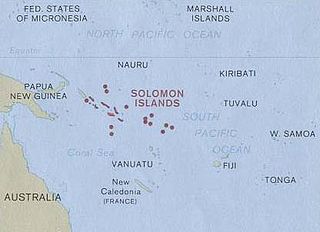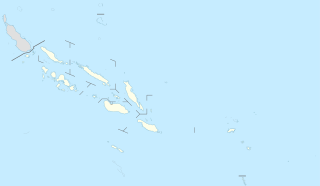La'aka is a powerful ancestress and one of the most widely propitiated of spirits among the eastern Kwaio on Malaita, Solomon Islands. She is seen as both a protective figure who exemplifies maternal virtues and the productive powers of women and as a warrior whose deeds rivalled those of the ancient Kwaio strongmen who, as ancestral spirits (adalo), are propitiated and confer power to the living. [1] She is one of the great ancestors of about twelve to twenty generations ago, which do not represent the starting point of the deepest genealogies, but represent those believed to have founded the modern Kwaio way of life. [2]
Kwaio is an ethnic group found in central Malaita, in the Solomon Islands. According to Ethnologue, they numbered 13,249 in 1999. Much of what is known about the Kwaio is due to the work of the anthropologist Roger M. Keesing, who lived among them starting in the 1960s.

Malaita is the largest island of the Malaita Province in Solomon Islands. South Malaita Island, also known as Small Malaita and Maramasike for Areare speakers and Malamweimwei known to more than 80% of the islanders, is the island at the southern tip of the larger island of Malaita. A tropical and mountainous island, Malaita's pristine river systems and tropical forests have not been exploited. Malaita is the second most populous island of the Solomon Islands, with a population of 140,000, or more than a third of the entire national population. The largest city and provincial capital is Auki, on the northwest coast and is on the northern shore of the Langa Langa Lagoon. The people of the Langa Langa Lagoon and the Lau Lagoon on the northeast coast of Malaita call themselves wane i asi ‘salt-water people’ as distinct from wane i tolo ‘bush people’ who live in the interior of the island.

Solomon Islands is a sovereign state consisting of six major islands and over 900 smaller islands in Oceania lying to the east of Papua New Guinea and northwest of Vanuatu and covering a land area of 28,400 square kilometres (11,000 sq mi). The country's capital, Honiara, is located on the island of Guadalcanal. The country takes its name from the Solomon Islands archipelago, which is a collection of Melanesian islands that also includes the North Solomon Islands, but excludes outlying islands, such as Rennell and Bellona, and the Santa Cruz Islands.
In 1939 a priest above Uru named Noto'i received messages from La'aka that she had visited America and spoken with the American King, and announced that American warships would come and kill all British colonial officials. On the basis of these pronouncements, many Kwaio built houses to accommodate the American visitors. Messages from La'aka were spoken in tongues, then translated by Noto'i. British officers arrested Noto'i and his followers, and when the Americans did not appear, many believers became disillusioned, though the movement continued underground for several years. [3]

The United States of America (USA), commonly known as the United States or America, is a country composed of 50 states, a federal district, five major self-governing territories, and various possessions. At 3.8 million square miles, the United States is the world's third or fourth largest country by total area and is slightly smaller than the entire continent of Europe's 3.9 million square miles. With a population of over 327 million people, the U.S. is the third most populous country. The capital is Washington, D.C., and the largest city by population is New York City. Forty-eight states and the capital's federal district are contiguous in North America between Canada and Mexico. The State of Alaska is in the northwest corner of North America, bordered by Canada to the east and across the Bering Strait from Russia to the west. The State of Hawaii is an archipelago in the mid-Pacific Ocean. The U.S. territories are scattered about the Pacific Ocean and the Caribbean Sea, stretching across nine official time zones. The extremely diverse geography, climate, and wildlife of the United States make it one of the world's 17 megadiverse countries.
By 1942, the British had in fact scattered in the face of the Japanese invasion, and the Americans came later in the Guadalcanal campaign. Malaita was in general not involved in World War II, but many Kwaio volunteered for the Solomon Island Labour Corps positions assisting the Americans on Guadalcanal or Tulagi. They found Americans generous and suspicious of colonial motives in a way the British had not been, and their experience with the Americans led to the anti-colonial movement Maasina Ruru. [4]

The Empire of Japan was the historical nation-state and great power that existed from the Meiji Restoration in 1868 to the enactment of the 1947 constitution of modern Japan.

World War II, also known as the Second World War, was a global war that lasted from 1939 to 1945. The vast majority of the world's countries—including all the great powers—eventually formed two opposing military alliances: the Allies and the Axis. A state of total war emerged, directly involving more than 100 million people from over 30 countries. The major participants threw their entire economic, industrial, and scientific capabilities behind the war effort, blurring the distinction between civilian and military resources. World War II was the deadliest conflict in human history, marked by 50 to 85 million fatalities, most of whom were civilians in the Soviet Union and China. It included massacres, the genocide of the Holocaust, strategic bombing, premeditated death from starvation and disease, and the only use of nuclear weapons in war.

Guadalcanal is the principal island in Guadalcanal Province of the nation of Solomon Islands, located in the south-western Pacific, northeast of Australia. The island is mainly covered in dense tropical rainforest and has a mountainous interior.




